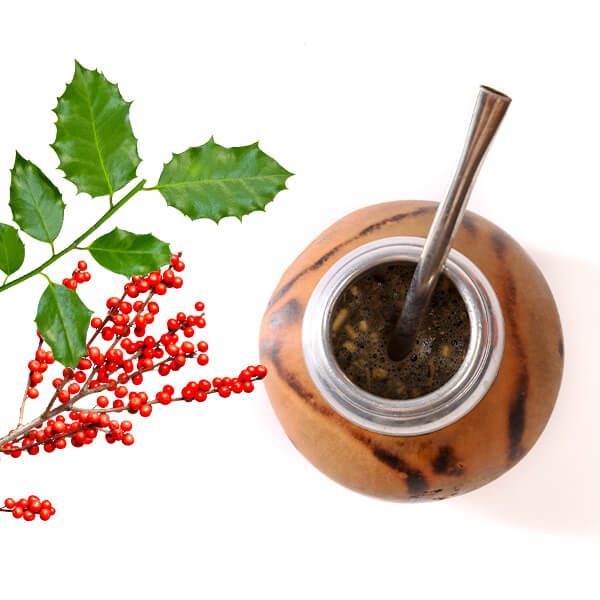Ilex paraguariensis, ilex guayusa, ilex dumosa... What are the differences?

Ilex paraguariensis, the plant used to make yerba mate, comes from the holly family, which includes around 600 species! Many of them are ornamental plants, while several holly plants have been appreciated for their valuable properties and have been used for brewing tea for centuries. In the tropical rainforests of South America, apart from ilex paraguariensis, there are also ilex guayusa and ilex dumosa. What are the differences between yerba mate’s sisters and why have they not become equally popular?
Ilex guayusa - Ecuadorian sister of yerba mate
Ilex guayusa is an evergreen tree with elliptical leaves, with smooth or serrated edges. It grows up to 30 metres tall - that's twice as tall as the Paraguayan holly. It is found throughout Ecuador, Peru and southern Colombia, with the largest crops located in the Ecuadorian provinces of Napo and Pastaza. Similarly to yerba mate, guayusa has a strong stimulating and antioxidant effect. It contains a large amount of vitamins, minerals and caffeine - approximately 1.73-3.48 % (the leaves of ilex paraguariensis contain approximately 0.9-1.8 % caffeine). In addition to caffeine, it also contains l-theanine, which affects the nervous system, stabilising mood and reducing feelings of stress. The effect of guayusa is therefore different from yerba mate - more harmonious. It is also slightly different in taste. It contains fewer tannins, which are responsible for the bitterness and astringency typical of yerba mate. The Jivaro and Kichwa Indians were the first to discover the stimulating properties of guayusa, and they used it to prepare for hunting. An infusion of guayusa was also used by them to induce conscious dreams, which were supposed to help predict the future. Despite having very similar effects, only yerba mate has gained worldwide fame, being a healthy alternative to tea and coffee. During colonial times, guayusa was grown on plantations in the same way as the ilex paraguariensis, but exotic fruits - bananas, mangoes or pineapples - became much more popular and desirable export products from Ecuador. Ilex guayusa remained in their shadow and for many years was a secret of the indigenous inhabitants of South America. Today, it is slowly being introduced to the world market, and more and more people can learn about its properties.

Yerba mate without caffeine - ilex dumosa
Ilex dumosa is a plant that grows as shrubs and trees, reaching an average height of around 6 m. Its leaves are more elongated and less oval. It grows in Argentina, Paraguay and Brazil. In comparison with ilex paraguariensis and ilex guayusa, it contains practically no caffeine - it is said to be about 1 per mille of the amount found in classic yerba mate. At the same time, ilex dumosa has a similar amount of vitamins, minerals and antioxidants as yerba mate. Due to the lack of stimulating ingredients, the infusion of ilex dumosa was recommended for people who do not like or cannot consume caffeine - because of cardiovascular or nervous system diseases, sleep disorders or in connection with hyperactivity. Among the local people, the drink was known as “yerba señorita”. In the early years of the 20th century, ilex dumosa was cultivated together with ilex paraguariensis, and their leaves were often mixed together. In 1935, a special commission was set up to regulate the law on mate production, which established that dried traditional yerba mate should consist of 100 % of holly leaves. Yerba señorita was therefore banned. It was not until the 1990s that the Argentine company Las Marías carried out a study that brought back the cultivation of the forgotten species of ilex dumosa and put it back on the list of food products. Nowadays, there are several blends on the market that contain this variety of holly, but they are still far from the popularity of yerba mate.
Infusions of holly leaves not only in South America
Plants of the holly family can be found on almost every continent of our world. There are also other species growing outside South America known for their highly stimulating or medicinal properties. During rituals, North American Indians prepared an infusion called "black drink" from the leaves of ilex vomitoria (commonly called yaupon) or ilex cassine (commonly called dahoon or cassena), which contain a high concentration of caffeine. Drinking the black drink caused vomiting, which the Indians saw as a symbol of cleansing a body and mind of negative emotions. Varieties of holly also grow in Asia - ilex kaushue (another name: ilex kudingcha) in China and Vietnam and ilex latifolia in China and Japan. These plants are used to prepare a very bitter-tasting infusion called kuding, which has many health-promoting properties.




